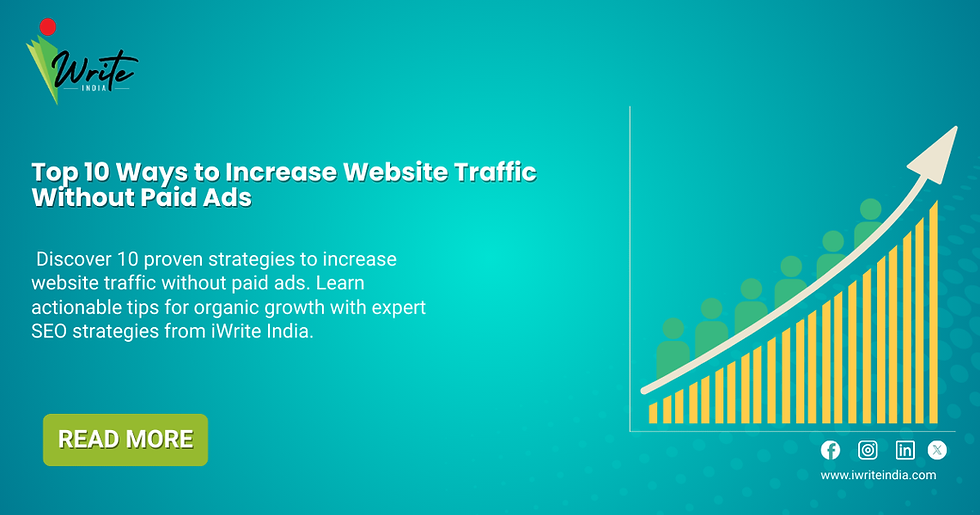Top 10 Tactics and Tips To Reduce Cost Per Acquisition
- iWrite India
- May 19
- 4 min read

In 2025, with digital ad spends growing rapidly across platforms, businesses—especially small and medium ones—are feeling the squeeze. The Cost Per Acquisition (CPA) is a critical metric for any business running paid campaigns. A high CPA eats into your margins, weakens your marketing ROI, and limits scalability.
This comprehensive guide will walk you through the top 10 proven tactics on how to reduce CPA, drawn from years of hands-on Google Ads experience and the latest industry data. Whether you're running eCommerce ads, generating B2B leads, or promoting a local service, these strategies can significantly optimize your ad spend and help you achieve a target CPA in Google Ads more effectively.
1. Sharpen Your Audience Targeting
Precise targeting is foundational to reducing CPA. Leverage Google’s in-market and affinity segments, customer match, and similar audiences. Geo-target only high-performing areas and use demographic filters to exclude low-intent traffic. Better targeting means fewer wasted clicks, which is central to how to reduce CPA.
2. Set Conversion Goals That Matter
Track actions that truly represent business success—not just vanity metrics. Focus on macro conversions (like purchases or lead forms) over micro conversions (like page views). Aligning goals with true business value helps Google optimize for users most likely to convert, aiding your target CPA Google Ads efforts.
3. Run Continuous A/B Testing
From ad creatives to landing page headlines, everything should be tested. Use Google Ads Experiments or third-party tools like VWO to test versions of your ads and pages. Systematic A/B testing is a powerful tactic in your arsenal for how to reduce CPA effectively.
4. Use Responsive Ads
Responsive Search and Display Ads let Google automatically test combinations to find top performers. Incorporate multiple headlines, descriptions, and visuals. These AI-optimized ads can be part of cost effective marketing ideas that scale efficiently without heavy manual oversight.
5. Implement Smart Bidding Strategies
Smart bidding, especially target CPA Google Ads, uses machine learning to predict and optimize bids for each auction. Start with historical CPA benchmarks and adjust as performance stabilizes. Smart bidding allows you to optimize ad spend while achieving consistent cost control.
6. Enhance Landing Page Experience
Landing pages are where conversions happen. Ensure mobile responsiveness, fast load speeds, compelling CTAs, and clear messaging. Improved landing experiences result in higher Quality Scores and lower CPCs, directly helping you reduce CPA.
7. Leverage AI and Automation Tools
Automation tools like dynamic keyword insertion, real-time bidding, and AI ad copy generators are increasingly powerful. These tools help automate and personalize campaigns, making them highly cost effective marketing ideas for small businesses.
8. Remove Underperforming Keywords and Placements
Review search terms and placement reports regularly. Identify and eliminate keywords or placements with high spend and no conversions. This clean-up effort is essential for how to reduce CPA while improving ROAS.
9. Run Strategic Retargeting Campaigns
Retarget visitors who showed high intent but didn’t convert. Use segmented audiences based on behavior and funnel stage. Retargeting typically drives a lower CPA and supports more efficient budget allocation, helping you optimize ad spend smartly.
10. Evaluate CPA in Context of ROI
Always consider customer lifetime value (CLTV) alongside CPA. Sometimes a higher CPA is justified for high-margin or repeat-purchase products. Balance CPA targets with profitability to ultimately increase ROI marketing efforts.
Bonus: Low-Cost Channels That Support CPA Goals
Diversify your acquisition strategy:
SEO and local search optimization
Email nurture sequences
Influencer and affiliate marketing These channels provide cost effective marketing ideas that reduce paid media dependency and can be useful small business marketing tips to reduce CPA indirectly.
How to Reduce CPA Effectively?
To reduce CPA (Cost Per Acquisition), refine your audience targeting, improve your landing pages, conduct regular A/B testing, and leverage automated bidding tools like target CPA in Google Ads. Enhancing user experience, using high-intent keywords, and continuously optimizing ad spend are key to sustainable CPA reduction.
Conclusion: Small Adjustments, Big CPA Wins
Reducing CPA isn’t about slashing budgets; it’s about strategic, data-informed decisions. By implementing these 10 tactics, you’ll not only discover how to reduce CPA, but also enhance your ad efficiency, scale responsibly, and make every marketing rupee count.
Work With Experts Who Know How to Reduce CPA
At iWrite India, we specialize in optimizing paid campaigns for small businesses and large enterprises alike. Whether you're struggling to find your target CPA in Google Ads or looking for cost effective marketing ideas to boost ROI, our digital experts can build a strategy tailored to your goals.
FAQs
1. How do I set a realistic CPA goal for my business?
Start by calculating your average customer value and profit margin. A realistic CPA is one that allows you to acquire customers profitably. Consider historical data and competitor benchmarks.
2. Can smart bidding alone reduce my CPA?
Smart bidding is powerful, especially with target CPA Google Ads, but it must be used alongside clean tracking, strong creatives, and optimized landing pages to be effective.
3. What are some low-budget tactics to reduce CPA?
Use retargeting, focus on organic SEO, and engage in email marketing. These methods reduce dependency on paid traffic and are excellent small business marketing tips for saving money.
4. Why is landing page optimization critical for CPA?
Even if your ads are great, a poor landing page will tank conversions. A smooth, persuasive landing page experience ensures you make the most of every click, thus reducing CPA.
5. How often should I review and adjust my CPA strategy?
Review campaigns weekly and assess performance trends over 2–4 week periods. Regular audits help you optimize ad spend and respond proactively to data shifts.




![Top 5 Digital Marketing Agencies in Delhi [2025 Updated]](https://static.wixstatic.com/media/53afe3_a718f2b4f3ae4a75becb77146127a742~mv2.png/v1/fill/w_980,h_515,al_c,q_90,usm_0.66_1.00_0.01,enc_avif,quality_auto/53afe3_a718f2b4f3ae4a75becb77146127a742~mv2.png)

Comments